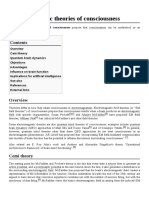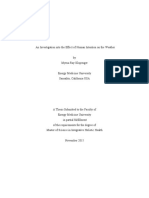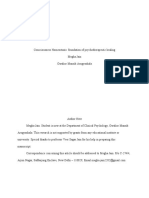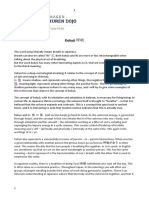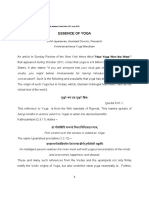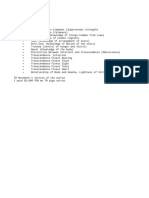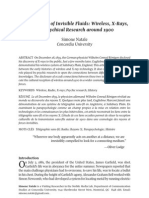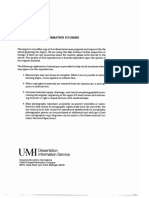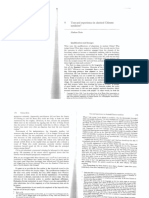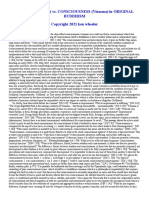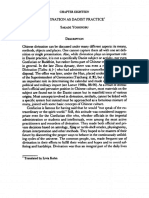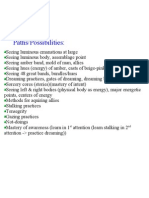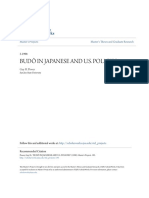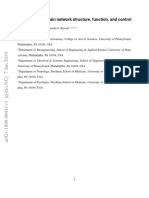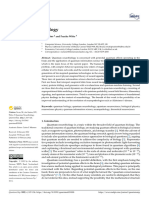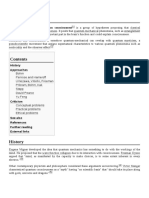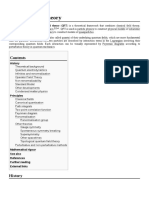Quantum brain dynamics
In neuroscience, quantum brain dynamics (QBD) is a hypothesis to explain the function of the brain within
the framework of quantum field theory.
As described by Harald Atmanspacher,[1] since quantum theory is the most fundamental theory of matter that
is currently available, it is a legitimate question to ask whether quantum theory can help us to understand
consciousness.[2]
Large systems, such as those studied biologically, have less symmetry than the idealized systems or single
crystals often studied in physics. Jeffrey Goldstone proved that where symmetry is broken, additional bosons,
the Nambu–Goldstone bosons, will then be observed in the spectrum of possible states; one canonical example
being the phonon in a crystal.
Ricciardi and Umezawa proposed in 1967 a general theory of quanta of long-range coherent waves within and
between brain cells, and showed a possible mechanism of memory storage and retrieval in terms of Nambu–
Goldstone bosons.[3] This was later fleshed out into a theory encompassing all biological cells and systems in
the quantum biodynamics of Del Giudice and co-authors.[4][5] Mari Jibu and Kunio Yasue later popularized
these results and discussed the implications towards consciousness.[6][7][8]
See also
Electromagnetic theories of consciousness
Neuroplasticity
Quantum mind
Shadows of the Mind, 1994 book by Roger Penrose
Quantum Aspects of Life (book)
Quantum mysticism
References
1. Atmanspacher, Harald (2 June 2015) [30 November 2004]. "Quantum Approaches to
Consciousness" (http://plato.stanford.edu/entries/qt-consciousness/). Stanford Encyclopedia of
Philosophy. Center for the Study of Language and Information (CSLI), Stanford University.
Retrieved 17 February 2016.
2. Van den Noort M, Lim S, Bosch P (2016). "On the need to unify neuroscience and physics" (htt
p://nnjournal.net/article/view/1855/1275). Neuroimmunology and Neuroinflammation. 3: 271–
273. doi:10.20517/2347-8659.2016.55 (https://doi.org/10.20517%2F2347-8659.2016.55).
3. Ricciardi LM, Umezawa H (1967). "Brain and physics of many-body problems". Kybernetik. 4:
44–48. doi:10.1007/bf00292170 (https://doi.org/10.1007%2Fbf00292170). PMID 5617419 (http
s://pubmed.ncbi.nlm.nih.gov/5617419).
4. Del Giudice E, Doglia S, Milani M, Vitiello G (1986). "Electromagnetic field and spontaneous
symmetry breaking in biological matter". Nucl. Phys. B. 275: 185–199. doi:10.1016/0550-
3213(86)90595-x (https://doi.org/10.1016%2F0550-3213%2886%2990595-x).
5. Del Giudice E, Preparata G, Vitiello G (1988). "Water as a free electric dipole laser". Physical
Review Letters. 61: 1085–1088. doi:10.1103/physrevlett.61.1085 (https://doi.org/10.1103%2Fp
hysrevlett.61.1085).
� 6. Jibu M, Yasue K (1995). Quantum Brain Dynamics: An Introduction. Amsterdam: John
Benjamins.
7. Jibu M, Yasue K (1997). "What is mind? Quantum field theory of evanescent photons in brain
as quantum theory of consciousness". Informatica. 21: 471–490.
8. Yasue, Kunio. "Quantum Monadology" (https://web.archive.org/web/20140625024817/http://co
gnet.mit.edu/posters/TUCSON3/Yasue.html). Toward a Science of Consciousness. Archived
from the original (http://cognet.mit.edu/posters/TUCSON3/Yasue.html) on June 25, 2014.
Retrieved from "https://en.wikipedia.org/w/index.php?title=Quantum_brain_dynamics&oldid=957155716"
This page was last edited on 17 May 2020, at 09:48 (UTC).
Text is available under the Creative Commons Attribution-ShareAlike License; additional terms may apply. By using this
site, you agree to the Terms of Use and Privacy Policy. Wikipedia® is a registered trademark of the Wikimedia
Foundation, Inc., a non-profit organization.
